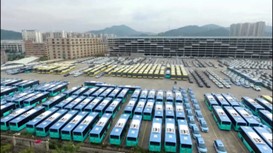- Country: Other
- Sector: Buses
- Area of Action: Urban transport
- Type of service: Municipality/public service
- Power source: Electric
- Aspects described in the case study:
- Technical features of e-buses and actual developments
- Charging infrastructure construction and operation
- Digital solutions assisting the use and operation of e-buses
- Training of e-bus drivers
- Training of e-bus maintenance staff
- Eco driving
- Health and business environment of e-bus driving
CONTEXT
Shenzhen, a Chinese city with more than 12 million inhabitants, is a remarkable example of electrified urban transport. This densely populated city has completely switched to a fleet of electric buses. This was not a pilot project, but a full implementation of the public bus network. Shenzhen made this decision to address environmental and health issues, reducing carbon emissions and improving air quality. It also sought to lead the revolution in technological innovation and urban sustainability.
Shenzhen’s electric bus fleet numbers more than 16,000 vehicles. The replacement began in 2009, and by 2017 they had retired the last diesel bus. This shift has been driven by a combination of favorable government policies, subsidies for the purchase of electric buses, and the construction of extensive charging infrastructure.

THE PROCESS
The process of technical and operational implementation of electric buses in Shenzhen followed a series of carefully planned steps:
- Planning and Investment: The city of Shenzhen, with the support of the central government, invested billions of yuan in the purchase of electric buses and the development of the necessary infrastructure. Strategic planning was undertaken to determine routes, energy demand, and optimal locations for charging stations.
- Infrastructure Development: Shenzhen built more than 8,000 charging stations, strategically distributed throughout the city to ensure that buses always had access to charging. These stations include both fast chargers and slow chargers to meet various operational needs.
- Technology Integration: Advanced digital solutions were implemented to manage fleet operations. These mainly included real-time monitoring systems, route management applications, and predictive diagnostic tools for bus maintenance.
- Training Programs: Extensive training programs were conducted for drivers and maintenance personnel. Drivers were trained in eco-driving and electric bus operation, while maintenance personnel were trained in specific techniques for repairing and maintaining electric vehicles.
- Awareness Campaigns: Initiatives were launched to educate the public about the benefits of electric buses and promote their acceptance. These campaigns included community workshops, informational materials, and school activities.
Collaboration among multiple stakeholders, including government agencies, private companies, and the community, was crucial to the success of this project. Partnerships were established with electric bus manufacturers such as BYD, promoting innovation in the sector.

IMPACT
The transition to electric buses in Shenzhen has had a significant impact in several respects:
- Environmental Benefits: The city has achieved an annual reduction of 1.35 million tons of carbon dioxide emissions and a considerable decrease in air pollution. This has contributed to a better quality of life for Shenzhen residents.
- Operational Efficiency: Electric buses have proven to be more economical in the long run due to lower fuel and maintenance costs. Although the initial investment was high, operational savings have helped amortize these costs.
- Public Health: Improved air quality has had positive effects on public health, reducing respiratory illnesses and other air pollution-related conditions.
- Economic Growth: The initiative has boosted the local economy, creating jobs in the construction of charging infrastructure and in the manufacture and maintenance of electric buses. It has also positioned Shenzhen as a world leader in sustainable transportation.
- Training and Skills Development: More than 10,000 drivers and technicians have been trained and upskilled, improving their skills and opening up new career opportunities.
MORE INFORMATION
This experience shows the importance of government support and infrastructure investment for the success of transport electrification projects. It also highlights the need for comprehensive training programs and public awareness campaigns to ensure a smooth and efficient transition.
In Shenzhen, local and national policies have played a crucial role. Central government subsidies and tax incentive policies have facilitated the purchase of electric buses. In addition, stringent environmental regulations have driven the adoption of clean technologies.

MULTIMEDIA
Sources:
https://ie.unc.edu/wp-content/uploads/sites/1337/2019/06/Screen-Shot-2019-06-11-at-10.43.35-PM.png
https://www.eltiempo.com/bogota/en-shenzen-china-la-ciudad-con-todos-sus-buses-electricos-172710
Video:
